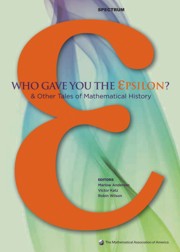Book contents
- Frontmatter
- Introduction
- Contents
- Analysis
- Geometry, Topology and Foundations
- Foreword
- Gauss and the Non-Euclidean Geometry
- History of the Parallel Postulate
- The Rise and Fall of Projective Geometry
- Notes on the History of Geometrical Ideas
- A note on the history of the Cantor set and Cantor function
- Evolution of the Topological Concept of “Connected”
- A Brief, Subjective History of Homology and Homotopy Theory in this Century
- The Origins of Modern Axiomatics: Pasch to Peano
- C. S. Peirce's Philosophy of Infinite Sets
- On the Development of Logics between the two World Wars
- Dedekind's Theorem:√2 × √3 = √6
- Afterword
- Algebra and Number Theory
- Surveys
- Index
- About the Editors
The Rise and Fall of Projective Geometry
from Geometry, Topology and Foundations
- Frontmatter
- Introduction
- Contents
- Analysis
- Geometry, Topology and Foundations
- Foreword
- Gauss and the Non-Euclidean Geometry
- History of the Parallel Postulate
- The Rise and Fall of Projective Geometry
- Notes on the History of Geometrical Ideas
- A note on the history of the Cantor set and Cantor function
- Evolution of the Topological Concept of “Connected”
- A Brief, Subjective History of Homology and Homotopy Theory in this Century
- The Origins of Modern Axiomatics: Pasch to Peano
- C. S. Peirce's Philosophy of Infinite Sets
- On the Development of Logics between the two World Wars
- Dedekind's Theorem:√2 × √3 = √6
- Afterword
- Algebra and Number Theory
- Surveys
- Index
- About the Editors
Summary
1 The early period
The subject of projective geometry occupied an important position on the mathematical stage during a large portion of the nineteenth century. In recent years it has moved considerably towards the wings. Why did it appear? Why was it prominent? Why is it now moving aside? These are pertinent questions which perhaps it is worth our while to consider.
First of all, what is projective geometry anyway? It is sometimes defined as that branch of geometrical science which deals with those properties of figures which are unaltered by radial projection from plane to plane or space to space, no matter what the number of dimensions involved. This definition is at once too large and too restrictive. The fact that the projective plane has the connectivity 1 or that, looked upon as an assemblage of points, it has the power of the continuum—this fact is invariant under projection, but is not usually looked upon as a projective property. On the other hand, the properties of a figure which are conserved by projection are invariant under the wider group of linear transformations. The proper use of the adjective projective would seemto be to describe those properties of figures which are invariant under the general linear transformation but not under all transformations of a wider group. The subject is vast. We can at present deal only with the most significant steps in its development.
- Type
- Chapter
- Information
- Who Gave You the Epsilon?And Other Tales of Mathematical History, pp. 125 - 132Publisher: Mathematical Association of AmericaPrint publication year: 2009

